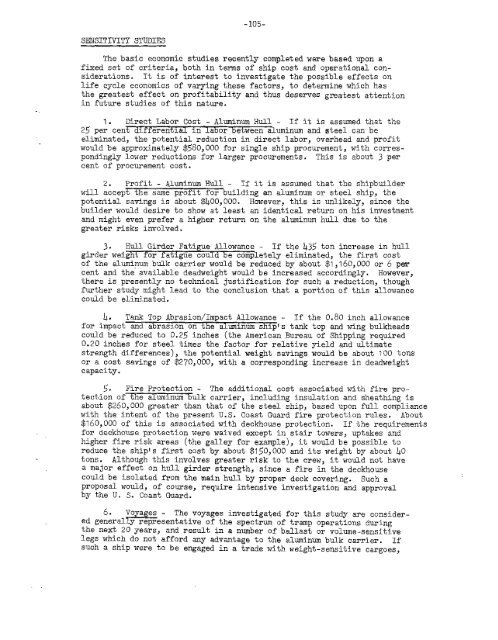design considerations for aluminum hull structures - Ship Structure ...
design considerations for aluminum hull structures - Ship Structure ...
design considerations for aluminum hull structures - Ship Structure ...
Create successful ePaper yourself
Turn your PDF publications into a flip-book with our unique Google optimized e-Paper software.
-1o5-SENSITIVITY STUDIESThe basic economic studies recently completed were based upon afixed set of criteria, both in terms of ship cost and operational considera%iorm.It is of in%erest to investigate the possible effects onlife cycle economics of varying these factors, to determine which hasthe greatest effect on p~ofitability and thus deserves greatest attentionin future studies of this nature.1. Direct Labor Cost - Aluminum Hull - If it is assumed that the25 per cent differential in labor between <strong>aluminum</strong> and steel can beeliminated, the potential reduction in direct labor, overhead and profitwould be approximately $580,000 <strong>for</strong> single ship procurement, with correspondinglylower reductions <strong>for</strong> larger procurements. This is about 3 pe~cent of procurement cost.2* Profit - Aluminum Hull - If it is assumed that the shipbuilderwill accept the same profit <strong>for</strong> building an <strong>aluminum</strong> or steel ship, thepotential savings is about $400,000. However, this is unlikely, since thebuilder would desire to show at least an identical return on his investmentand might even prefer a higher return on the <strong>aluminum</strong> <strong>hull</strong> due to thegreater risks involved.3. Hull Girder Fatigue Allowance - If the 43S ton increase in <strong>hull</strong>girder weight <strong>for</strong> fatigue could be completely eliminated, the first costof the <strong>aluminum</strong> bulk carrier would be reduced by about $1,160,000 or 6 psa’cent and the available deadweight would be increased accordingly. However,there is presently no technical justification <strong>for</strong> such a reduction, thoughfurther study might lead to the conclusion that a portion of this allowancecould be eliminated.4* Tank Top Abrasion/ImpactAllowance - If bhe 0.80 inch allowance<strong>for</strong> impact and abrasion on the <strong>aluminum</strong> shipls tank top and wing bulkheadscould be reduced to 0.2~ inches (the American Bureau of <strong>Ship</strong>ping required0.20 inches <strong>for</strong> steel times the factor <strong>for</strong> relative yield and ultimatestrength differences), the potential weight savings would be about 100 tonsor a cost savings of $270,000, with a corresponding increase in deadweightcapaci%y.5+ Fire Protection - The additional cost associated with fire protectionof the <strong>aluminum</strong> bulk carrier, including insulation and sheathing isabout $260,000 greater than that of the steel ship, based upon full compliancewith the intent of the present U.S. Coast Guard fire protection rules. About$160,000 of this is associated with deckhouse protection. If the requirements<strong>for</strong> deckhouse protection were waived except in stair towers, uptakes andhigher fire risk areas (the galley <strong>for</strong> example), it would be possible toreduce the shipls first cost by about $1~0,000 and its weight by about 40tons. Although this involves greater risk to the crew, it would not havea major effect on <strong>hull</strong> girder strength,since a fire in the deckhousecould be isolated from the main <strong>hull</strong> by proper deck covering. Such aproposal would, of course, require intensive investigation and approvalby the U. S. Coast Guard.6. Voyages - The voyages investigated <strong>for</strong> this study are consideredgeneralmesentative of the spectrum of tramp operations duringthe next 20 years, and result in a number of ballast or volume-sensitivelegs which do not af<strong>for</strong>d any advantage to the <strong>aluminum</strong> bulk carrier. Ifsuch a ship were to be engaged in a trade with weight-sensitive cargoes,
















